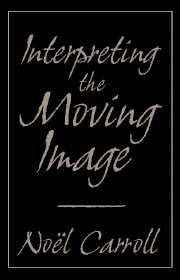Book contents
- Frontmatter
- Contents
- Foreword: Through Carroll's Looking Glass of Criticism
- Introduction
- 1 The Cabinet of Dr. Kracauer
- 2 Entr'acte, Paris and Dada
- 3 The Gold Rush
- 4 Keaton: Film Acting as Action
- 5 Buster Keaton, The General, and Visible Intelligibility
- 6 For God and Country
- 7 Lang, Pabst, and Sound
- 8 Notes on Dreyer's Vampyr
- 9 King Kong: Ape and Essence
- 10 Becky Sharp Takes Over
- 11 Interpreting Citizen Kane
- 12 The Moral Ecology of Melodrama: The Family Plot and Magnificent Obsession
- 13 Mind, Medium, and Metaphor in Harry Smith's Heaven and Earth Magic
- 14 Welles and Kafka
- 15 Nothing But a Man and The Cool World
- 16 Identity and Difference: From Ritual Symbolism to Condensation in Anger's Inauguration of the Pleasure Dome
- 17 Text of Light
- 18 Joan Jonas: Making the Image Visible
- 19 Introduction to Journeys from Berlin/1971
- 20 The Future of Allusion: Hollywood in the Seventies (and Beyond)
- 21 Back to Basics
- 22 Amy Taubin's Bag
- 23 Herzog, Presence, and Paradox
- 24 Film in the Age of Postmodernism
- Notes
- Index
5 - Buster Keaton, The General, and Visible Intelligibility
Published online by Cambridge University Press: 05 June 2012
- Frontmatter
- Contents
- Foreword: Through Carroll's Looking Glass of Criticism
- Introduction
- 1 The Cabinet of Dr. Kracauer
- 2 Entr'acte, Paris and Dada
- 3 The Gold Rush
- 4 Keaton: Film Acting as Action
- 5 Buster Keaton, The General, and Visible Intelligibility
- 6 For God and Country
- 7 Lang, Pabst, and Sound
- 8 Notes on Dreyer's Vampyr
- 9 King Kong: Ape and Essence
- 10 Becky Sharp Takes Over
- 11 Interpreting Citizen Kane
- 12 The Moral Ecology of Melodrama: The Family Plot and Magnificent Obsession
- 13 Mind, Medium, and Metaphor in Harry Smith's Heaven and Earth Magic
- 14 Welles and Kafka
- 15 Nothing But a Man and The Cool World
- 16 Identity and Difference: From Ritual Symbolism to Condensation in Anger's Inauguration of the Pleasure Dome
- 17 Text of Light
- 18 Joan Jonas: Making the Image Visible
- 19 Introduction to Journeys from Berlin/1971
- 20 The Future of Allusion: Hollywood in the Seventies (and Beyond)
- 21 Back to Basics
- 22 Amy Taubin's Bag
- 23 Herzog, Presence, and Paradox
- 24 Film in the Age of Postmodernism
- Notes
- Index
Summary
While watching a film the spectator undergoes a variety of cognitive experiences – observing, speculating, recognizing, inferring, interpreting, and so on. The film theorist André Bazin drew a distinction between what he considered the two basic types of cinema viewing. The first, which he associated with editing, seems connected primarily to inference since the spectator must fill in so many unseen details as well as spatial and narrative relations. The second, which he associated with the single shot – specifically, those presented via deep-focus photography – is more a matter of observation. That is, with editing, relations are implied that the spectator is supposed to supply by induction; whereas with the single shot done in the deep-focus medium-long shot (a shot in clear focus throughout with two or more planes of action), the spectator is meant to see and to take note of the relevant relations.
It seems to me that there are more categories of cognitive experience than this in cinema viewing and that they are not necessarily linked to editing versus shot composition in a one-to-one correspondence. In this essay I will use an analysis of Buster Keaton's film The General to discuss further, more fine-grained distinctions that need not always be mapped onto an opposition between composition versus editing.
My method will be functional, using the language of goals to describe the cinematic organization of an event and analyzing how formal arrangements facilitate those goals.
- Type
- Chapter
- Information
- Interpreting the Moving Image , pp. 64 - 79Publisher: Cambridge University PressPrint publication year: 1998
- 1
- Cited by

